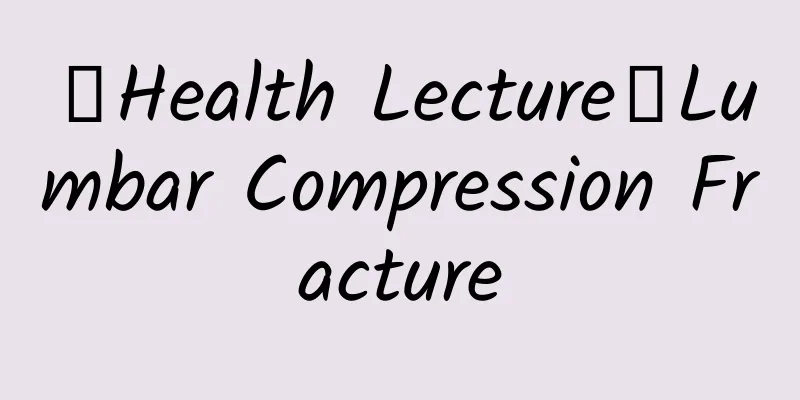【Health Lecture】Lumbar Compression Fracture

|
In order to ensure the scientific effect of learning health knowledge in the "2024 China Elderly Health Knowledge Competition", the organizer has collected various health science articles suitable for the elderly from various hospitals. We will share them through the "Health Lecture Hall" column. Today, Mr. Tian Kangsong from the Traumatology Department of Zibo Central Hospital will bring "Lumbar Compression Fractures". Elderly friends are welcome to learn. Lumbar compression fracture means that the lumbar vertebrae have been flattened and the internal structure of the bones has been destroyed. Lumbar compression fracture means that the height of the vertebrae is lower than before and needs to be restored through treatment. Lumbar compression fractures are more common in the elderly. In real life, lumbar compression fractures in the elderly are a common injury and cause great harm, causing serious mental distress to the elderly. If an elderly person has a lumbar compression fracture, how should it be handled? What should be paid attention to? We all know the saying, "Old people are more vulnerable to injuries and diseases due to the deterioration of their body functions. In particular, some traumatic injuries have a great impact on the health of the elderly. The treatment of lumbar compression fractures in the elderly also needs to be determined according to the degree of lumbar compression fractures in the elderly. Cause: Lumbar compression fractures are more common in middle-aged and elderly people. After the fracture, the height of the vertebral body is much lower than before, sometimes accounting for one-half or one-third. Generally speaking, osteoporosis is prone to lumbar fractures, and severe trauma can also cause lumbar fractures. Most osteoporotic fractures in the elderly are compression fractures, and the injuries are generally minor. They can also manifest as stress fractures, which are caused by repeated accumulation of minor injuries. Pathological fractures usually refer to bone tuberculosis, bone tumors invading the vertebrae resulting in minor injuries, or fractures caused by no trauma. Osteoporotic fractures can also be regarded as pathological fractures. Osteoporosis mainly refers to the decrease in bone density and bone quality due to various reasons. These factors will cause the patient's bone microstructure to be destroyed, increase the brittleness of the bone, and make the whole body prone to fractures. As my country enters an aging society, the impact of osteoporosis on public health is becoming increasingly serious. Osteoporotic fractures are brittle fractures and are the most serious consequence of osteoporosis. Due to the decrease in bone strength, minor trauma and even daily activities can also lead to osteoporotic fractures. The most common sites for osteoporotic fractures are the spine, hip, wrist, and shoulder. The risk of re-fracture after an osteoporotic fracture is significantly increased. Therefore, while treating fractures, osteoporosis should also be actively treated. Clinical manifestations: The injury history should be carefully understood. The patient complains of back pain and fear of movement, which may hinder standing and walking. If the compression is severe, the spinous process or ligament of the posterior column is damaged, resulting in local kyphosis or swelling and ecchymosis. Tenderness and percussion pain are common, and the thoracolumbar spine is limited in movement. Most thoracolumbar compression fractures are stable fractures, and few patients are paralyzed by spinal cord injury. Diagnosis: X-ray is the most commonly used examination method, but the discovery of vertebral compression and wedge-shaped deformation does not necessarily mean a fracture or a fresh fracture. Vertebral malformation can cause vertebral wedge-shaped changes, and old fractures remain. Attention should be paid to the vertebral contour and trabecular structure. CT is helpful in observing trabecular fractures and cortical fractures. MRI shows diffuse low signals on T1WI for fresh compression fractures, iso-signal or high signals on T2WI, and high signals on fat-suppressed phases, which can also show vertebral arch damage and soft tissue damage. Treatment: Simple lumbar compression fractures are mostly stable fractures with no neurological damage symptoms. A few vertebrae are severely wedge-shaped, and the vertebral arch, the appendage located at the back of the spine, may have tension damage, which manifests as unstable fractures. In the acute stage, the patient needs to lie flat on a hard bed and turn over in a balanced manner, that is, the caregiver holds the patient's shoulders and hips and rolls over to avoid twisting the trunk, and the patient cooperates to tighten the trunk muscles. After a fracture, retroperitoneal hematoma often stimulates the visceral nerves, causing intestinal peristalsis disorders, abdominal distension and abdominal pain. After the injury, it is often necessary to fast and receive fluid support, and gradually drink water and eat depending on the recovery of bowel sounds. After the pain is relieved and the abdominal distension subsides, the body position can be reduced under the guidance of a doctor according to the degree of fracture compression. For example, pillows can be gradually placed on the back of the injured vertebra, using this as a fulcrum to use the gravity of the trunk to maintain the spine in dorsiflexion, so as to stretch the wedge-shaped compressed vertebral body, improve and correct the deformity, and reduce the fracture. A chest and back brace must be worn when standing and walking. Turn over regularly, pat and massage the back, encourage the patient to cough and expectorate, keep the skin clean and dry, and prevent lung infections and bedsores. Vertebral compression fractures in the elderly are often caused by osteoporosis. Such fractures are often difficult to heal, and a small operation may be required to relieve pain and prevent the spinal deformity from worsening. For a few unstable fractures, open reduction and internal fixation can be performed. For fresh osteoporotic fractures in the elderly, positional reduction can be performed under the guidance of X-ray CT, and bone cement can be injected into the gap between the injured vertebral fractures. Alternatively, an air bag can be injected first, and then bone cement can be injected after expansion to expand the compressed vertebrae, strengthen the injured vertebrae, and prevent further collapse of the vertebrae. As the injured vertebrae stabilize, the patient's pain will be relieved and eliminated. Rehabilitation: Generally within 3 months after injury, it is the healing period, and patients mainly exercise in bed. Rehabilitation exercises should be started as early as possible, 1-2 days after injury, to increase the strength of the waist and back muscles and restore the stability of the spine. The waist and back muscle training can adopt the "five-point support method", that is, the patient takes a supine position, supports the body with the head, elbows and feet, and lifts the waist upward, trying to stretch back in the air; the patient can also take a prone position, straighten and extend the upper limbs, tilt the head and chest back, and lift the abdomen, or straighten and extend the lower limbs. Patients with good physical fitness can also extend the upper and lower limbs at the same time in an arc. It is worth noting that this is the healing period of bones. It is necessary to avoid flexion of the spine and it is not advisable to stand upright and bear weight too early, so as not to aggravate the deformation of the fractured vertebra and affect the healing of the fracture. While doing waist exercises, patients should pay attention to the activities of the joints of the limbs to prevent disuse atrophy of limb muscles, joint contracture and bone decalcification. Rhythmic exercises of the joints of the lower limbs can promote blood circulation and prevent thrombosis in the lower limbs. Patients should also strengthen respiratory function exercises to maintain normal lung function. The recovery period begins 3 months after the injury. The patient should continue to strengthen the back muscles to prevent residual back pain. At the same time, the flexibility and mobility of the spine should be exercised. The patient can sit on a gymnastics bench and bend the spine in all directions to prevent the spinal cord joint from replacing the waist. The training to strengthen the back muscles can be combined with appropriate abdominal muscle training. Author: Tian Kangsong Image: Qianku.com About the Author Tian Kangsong, attending physician, traumatology orthopedics, West Campus of Zibo Central Hospital, master's student, member of the Communist Party of China, graduated from Soochow University's national key department, orthopedics in 2010. He has published three SCI papers and three utility model patents since he started working. He is an excellent teaching teacher at Binzhou Medical College. He is currently a member of the Science Popularization and Health Education Working Committee of the Chinese Medical Education Association, a member of the Orthopedic Surgery Professional Committee of the Shandong Pain Medicine Association, a member of the Orthopedic Surgery Youth Professional Committee of the Shandong Pain Medicine Association, and a member of the Trauma Surgery Committee of Zibo City. His main research directions: treatment of severe multiple injuries, complex bone and joint trauma, spinal trauma, etc. He is good at: minimally invasive treatment of complex limb fractures. |
<<: Dental implants--our "third set of teeth"
>>: Applications and challenges of artificial intelligence in anesthesiology
Recommend
[Medical Q&A] What is the most common benign bone tumor?
Planner: Chinese Medical Association Reviewer: Sh...
What medicine can cure cervical erosion?
What Chinese medicine should I take for moderate ...
What are the characteristics of perimenopausal menstruation?
Under normal circumstances, women are likely to e...
Causes of dark brown vaginal discharge
Leucorrhea begins to appear after puberty when th...
When is the best time to repot the keel flower? What should you pay attention to when repotting the keel flower?
Dragon bone flowers are quite common in life. Bec...
What to do when a girl has a headache
Headache is not a strange symptom for modern peop...
If a woman doesn't do this well, she will be hurt for life!
In recent years, the proportion of unmarried wome...
Bleeding thought to be menstruation but actually pregnancy
Under normal circumstances, there will be no vagi...
Do you need to wash jackfruit before eating it? Why can't you eat shredded jackfruit?
Jackfruit is also called jackfruit and tree pinea...
Traditional Chinese medicine diet can keep you away from menstrual abnormalities
Women have such a few days every month. If these ...
What to do if there is a lump in the breast and it hurts during breastfeeding
Women who are breastfeeding must pay attention to...
The harm of disinfectant to pregnant women
Disinfectant is a common item in our lives. We us...
What should I do if I have presbyopia and cataracts?
People are still young, but their eyes are gettin...
"Aimei Yi" prevention and treatment knowledge series - Hepatitis B
Hepatitis B, as an infectious disease caused by h...
What kind of yogurt is suitable for oatmeal? The correct method of making yogurt and fruit oatmeal
Many people who pay attention to their figure and ...









